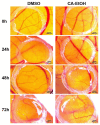Phytochemical profile and a preliminary in ovo screening of the ethanolic extract of Coffea arabica green seeds
- PMID: 40371415
- PMCID: PMC12070994
- DOI: 10.15386/mpr-2837
Phytochemical profile and a preliminary in ovo screening of the ethanolic extract of Coffea arabica green seeds
Abstract
Aims: Coffea arabica has garnered significant attention for its potential therapeutic applications due to its rich phytochemical profile, including chlorogenic acids, flavonoids, and alkaloids like caffeine, which are associated with antioxidant, anti-inflammatory, and antimicrobial effects. This study aimed to (i) evaluate the phytochemical composition of an ethanolic extract derived from green seeds of Coffea arabica and (ii) perform a preliminary in ovo screening to determine its mucosal tolerability, irritant potential, and pro-angiogenic activity using the chick embryo chorioallantoic membrane (CAM) model.
Methods: An ethanolic extract was prepared from C. arabica green seeds and subjected to LC-MS analysis for the identification and quantification of polyphenols. The antioxidant capacity was assessed through the DPPH radical-scavenging assay, comparing extract performance to ascorbic acid as a standard. In ovo testing was conducted using the HET-CAM assay to observe potential irritation on the CAM surface and to evaluate angiogenic activity. Chick embryos were monitored for vascular changes, irritant signs (hemorrhage, lysis, coagulation), and overall tolerability post-application over six days.
Results: Phytochemical analysis confirmed the presence of chlorogenic acid and 4-O-caffeoylquinic acid in the extract. The extract exhibited substantial antioxidant activity (66.38%), though slightly lower than that of ascorbic acid (97.36%). In the HET-CAM assay, no signs of irritation or toxicity were observed, and the extract was well tolerated for up to six days post-application. Additionally, the extract promoted angiogenesis, with increased vascularization observed, suggesting a stimulatory effect on neovascularization without inducing tissue damage.
Conclusions: The ethanolic extract of Coffea arabica green seeds demonstrates promising antioxidant and pro-angiogenic properties, alongside high mucosal biocompatibility. These findings support its potential applications in therapeutic and cosmetic formulations, particularly those targeting tissue regeneration and skin repair. Further studies are recommended to explore the underlying mechanisms and to confirm efficacy in more advanced biological models.
Keywords: Arabica coffee; FT-IR spectroscopy; HET-CAM assay; LC-MS investigation; angiogenesis.
Figures






References
-
- Dewi E, Praharsini DF, Damayanti IGAA, Linawati PAA, Dinata IMK. Administration of Arabica coffee leaf extract (Coffea arabica) reduces tumor necrosis factor alpha (TNF-α) and sunburn cell levels in male Wistar rats (Rattus norvegicus) exposed to ultraviolet-B rays. International Journal of Scientific Advances. 2024;5:191–194.
-
- Martina S, Lelo A, Lindarto D, Ganie R, Ichwan M, Yusuf H, et al. The decreasing of homeostatic model assessment – insulin resistance levels after given coffee Arabica gayo leaf extract (Coffea arabica L.) to type 2 diabetes mellitus rats. Open Access Macedonian Journal of Medical Sciences. 2021;9:356–361.
-
- Rahasbistara M, Darmaputra I, Linawati M. Administration of Arabica coffee bean (Coffea arabica) cream extract from Wamena Papua can reduce MMP-1 and increase collagen in Wistar male rats (Rattus norvegicus) exposed to ultraviolet-B. International Journal of Research and Review. 2023;10(7):235–240.
LinkOut - more resources
Full Text Sources
